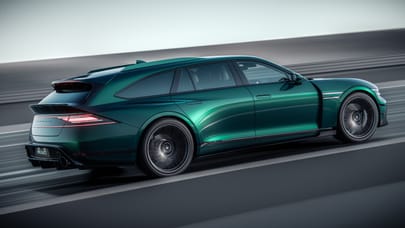
TG’s guide to concepts: the BMW GINA
Is BMW's stretchy, Z8-based roadster a future we're heading towards?


Feast your eyes on this – a heady combination of a V8 engine, an aluminium space frame and… well, spandex.
According to BMW, GINA stands for ‘Geometry and Functions in ’N’ Adaptations’, which roughly translates from design-speak to English as ‘this car can change shape in a bunch of different ways to suit what you want it to do and we think that’s pretty cool’.
And yes, as the eagle-eyed among you may have spotted, the actual name should be GAFINA, or perhaps GFNA, if we were to remove the conjunction and preposition.
In any case, underneath the spandex and inexpertly crafted acronyms beats the heart of the BMW Z8.
Advertisement - Page continues below
Remember the BMW Z8? Excellent. Do you remember it past its exceptionally fleeting appearance in The World is not Enough? Bravo to you.
On paper at least, the Z8 had the right stuff. It was built from aluminium, which kept it light. Its V8 engine was from the E39 M5, which made it powerful. The S62 V8 was mounted behind the front axle, which kept it balanced.
But, for some reason, the ‘Ultimate Driving Machine’ turned out to be anything but. There was quite a bit of understeer, likely dialled in by BMW engineers who didn’t want their top-tier convertible to be a yuppie killer in the same way the Porsche 930 was in the 1970s and ’80s.
But perhaps the Z8’s problem was more of perception than anything else – BMW had built a luxury droptop cruiser, not a track weapon. It’s like Heston Blumenthal offering up a delicious roast dinner – it falls flat only because you were expecting reconstituted molecules of confit duck on a bed of soba noodles.

So, you get an idea of what the GINA’s about – a gentlemanly cruiser, wrapped in spandex. And if that concept sounds a trifle strange to you, you’re not alone.
It was actually fairly ingenious – the whole ‘body’ of the car was actually a fabric skin, kind of like dance leggings, stretched over a metal wire and carbon-fibre structure. The piece de resistance of the whole thing was that the structures could move, which kind of made them like tendons, or ligaments, pulling and contorting the fabric to create new shapes as the driver saw fit.
Want to see the engine? Well, push a button and the bonnet prises itself open like a doctor’s bag. If you want larger wheel arches, that’s a press of a button away as well. We’d probably leave that switch on, but only because we’re Group B rally tragics. The GINA can grow its own rear spoiler, too, if you’re interested.
Advertisement - Page continues below
But, you may be wondering, what about the things you actually need out on the road, like indicators and headlights? Well, the fabric covering the rear LEDs is translucent, in that it lets light through without being entirely transparent. So, if you brake or indicate, those following can actually see your intentions.
The headlights, on the other hand, are much more theatrical. The front section moves, on either side of the traditional BMW kidney grille, opening up what can only be described as a pair of eyes to help you see down the road. Be assured that the analogy isn’t lost on us.

The cabin is designed (and upholstered) in the same manner as the exterior. Want a bit more headrest support? The GINA will grow and fill out to create a more enticing interior, while the gearstick, as BMW puts it, “protrudes from tightly stretched textile”. Oh my.
Still, the GINA is packed full of ideas that run counter to the assumed wisdom of building cars. BMW asks: “Does a car roof really have to rest on pillars and be bordered by windows?” Erm, conventional wisdom suggests yes.

But these days, more than ever before, an adaptive fabric car could really make sense. When you consider where the general performance benchmark is these days, the tightening strictures on emissions and the plethora of technology we’ve come to expect in new cars, manufacturers are quickly reaching somewhat of a paradox.
Steel is quickly becoming too heavy for extensive use in cars that need to be fast and fuel-efficient. Aluminium is expensive to refine from bauxite, and rather bad for the environment in the process. Carbon is still woefully expensive and plastics are a petrochemical byproduct.
So what could be a better answer than the sparing use of lightweight materials, covered by a hard-wearing and easily replaceable fabric cover?
All of a sudden, Mr Bangle is less of a kooky car designer (and infamous inventor of a certain rear end) and more of a Nostradamus type. Who would have thought?
Trending this week
- Car Review
BMW 1 Series







